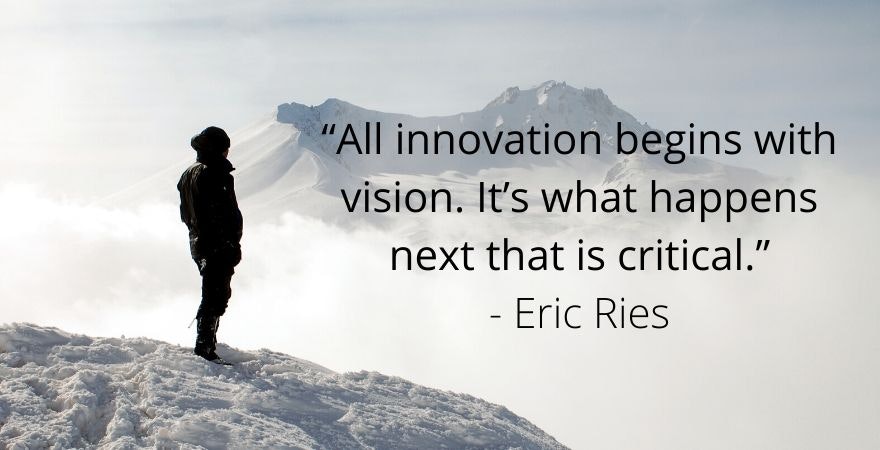It’s fair to say that The Lean Startup by Eric Ries transformed the world as we know it. A New York Times bestseller, the Lean Startup model is a global phenomenon, faithfully used by individual entrepreneurs and huge companies around the world – to astonishing results.
Given Eric Reis’ stunning credentials, he clearly knows what he’s talking about. Having worked as the CTO of the IMVU social network, the co-founder of FastWorks, the founder and CEO of the Long-Term Stock Exchange, and the entrepreneur-in-residence at Harvard Business School, IDEO and Pivotal, the Lean Startup business model is based on a wealth of lived experience.
To do this Lean Startup summary justice, we’ve mirrored the way Ries has structured the book which is split across three main sections:
- Vision – Here, Ries puts forward the case for a new discipline of entrepreneurial management.
- Steer – This section dives deeper into the Lean Startup business model.
- Accelerate – Here, the focus is on how to get Lean Startups to speed through the ‘Build-Measure-Learn’ feedback loop as quickly as possible.
So, let’s get to grips with the revolutionary Lean Startup model.

Post Contents



The Lean Startup Summary and Review Part 1: Vision
The Definition and Origins of the Lean Startup
The Lean Startup model takes its name from the Toyota manufacturing revolution as lead by Taiichi Ohno and Shigeo Shingo. They transformed Toyota into a flourishing global company by focusing on the following principles:
- Drawing on the knowledge and creativity of individual employees
- Shrinking batch sizes
- Utilizing just-in-time production and inventory control
- Accelerating cycle times
This approach highlighted the difference between value-generating behavior, and waste – principles which the Lean Startup method carries across to the context of entrepreneurship.
Ries, therefore, firmly believes that startup success is not necessarily about having a great idea, or even being in the right place at the right time; it is about following the right processes. Consequently, the Lean Startup model is based on the following:
- Fast cycle times
- Focusing on what the customer wants (without asking them first)
- Using scientific approaches to make decisions
Thus, the Lean Startup business model is a novel approach to the development and innovation of new products which focuses on speedy iteration, customer insight, creative vision and sizable ambition, simultaneously.

Validated Learning – a Novel Approach to Data
The Lean Startup model boasts a unique concept that Reis refers to as “validated learning.” This approach to learning is more accurate, concise and quicker than traditional modes of market forecasting or corporate planning.
To first understand what validated learning means, we need to highlight which of our efforts are creating value, and which are creating waste. For example, rather than continually trying to update and improve a product, we should work out whether customers are interested in our product at all. Anything that isn’t providing value to the customer is waste.
But how can we know what our customers value in our product? The key is to ship out a version of the product as quickly as possible to obtain real data. Validated learning is the process of drawing conclusions from this data, based on actual customer behavior – not on the feedback customers may provide via a survey or interview about what they may hypothetically like about a product that they have not yet interacted with.
Essentially, don’t trust customers to know what they want ahead of time. Instead, trust the way they behave with a tangible version of the product and use this data to inform decisions going forward.
Freedom to Experiment is Essential
From the perspective of the Lean Startup, an experiment isn’t just a line of theoretical enquiry – it’s the first version of the product. As mentioned in the previous chapter, Reis emphasizes the importance of getting customers to interact with a product as quickly as possible as it is the results of this experimentation that determine the direction of the product.
Here, Reis brings in the fascinating example of Nick Swinmurn, the founder of Zappos, now the world’s biggest online shoe store. Before online shopping had really taken off, Nick systematically experimented with working out whether customers would be willing to buy shoes online by following this process:
- He approached local shoe stores and asked if he could take photos of their inventories.
- He posted the pictures online to see if customers would buy them.
- If they did, he would return to the store, buy the pair of shoes at full price, and send them on to the customer.
This approach is indicative of the Lean Startup method of experimentation. Rather than getting caught up in organizing an entire product line with inventories, warehouses and distributors, Zappos started small and employed the quickest way possible to test his hypothesis that there was a demand for online shoes.
Further, in doing so, Zappos didn’t engage in traditional methods of market research or customer surveys which would have asked what customers wanted rather than revealing their actual behavior. Instead, he was able to observe, interact with, and learn directly from the customers and distributors that participated in his small-scale experiment. In 2009, Amazon bought Zappos for $1.2 billion.
Therefore, validated learning and fast experimentation are integral to the Lean Startup business method. By the time the first iteration of a product has been distributed, it will have amassed a few customers and provided a wealth of data concerning what is and is not working in reality, rather than hypothesizing about what may work in the future. As Steve Blank, a Silicon Valley entrepreneur states, all of the data that we need to amass concerning customers, markets and suppliers, only exists “outside the building,” i.e. in the real world.
The Lean Startup Summary and Review Part 2: Steer
The Lean Startup Depends on Minimum Viable Products
Minimum viable products (MVPs) are essential to the Lean Startup method as they facilitate the process of validated learning as quickly as possible. Not to be confused with the smallest product that could be brought to market, they are simply the quickest and most effortless way to zip through the Build-Measure-Learn feedback loop. The Build-Measure-Learn feedback loop is the fundamental basis upon which a startup grows. First, a product is built and tested in the real world, then its successes and failures are measured, and then, from the measurable data, validated learning can inform the next stage in the product’s development.
MVPs vary wildly in complexity from simple advertisements to early prototypes. However, entrepreneurs tend to include too many features on their MVP – if in doubt, always simplify. Any feature that doesn’t contribute to what you need to learn should be removed as time spent on it will be a waste.
One of the most significant challenges entrepreneurs, and indeed teams in general, face when creating MVPs are the traditional notions of what quality means. Getting an MVP to market as quickly as possible will often not feel like a good representation of a professional’s complete skillset. This is where a new perspective needs to be adopted where the MVP is seen as a vital step towards building a high-quality product and without which, doing so will prove difficult.
An additional stumbling block is that MVPs, more often than not, do not garner positive feedback from customers. Of course, while this data is still valuable for validated learning and the Build-Measure-Learn feedback loop, such results can be interpreted as disheartening by a team. The solution is to prepare employees for such results, and instead encourage a commitment to iteration, innovation, and to see such setbacks as part of the process. Indeed, the MVP is just the first step on the learning journey.

Lean Startups Must Measure Their Successes and Failures Optimally
Often, startups measure their success by creating a milestone, interacting with a few customers and seeing if their overall numbers increase – but this is a flawed way of measuring progress. How can they be sure that the changes in numbers are related to the changes they’ve made? This is where Reis provides us with two excellent Lean Startup tools to effectively measure our results: Innovation accounting and actionable metrics. Let’s start by unpacking the former.
Innovation accounting allows startups to objectively prove that they are using validated learning to foster a sustainable business. It works in three steps:
- Implement an MVP to gain real data on the current status quo of the company. An MVP helps integrate real baseline customer data into a startup’s growth model, even if the customers don’t value the MVP at present.
- Startups must attempt to move towards their ideal baselines. Every initiative that a startup undertakes should be focused on improving just one of its growth drivers. For example, a startup might choose the activation rate of new customers as a driver for growth, and decide that at present, their baseline for this driver is too low. Consequently, they may revamp the design to make it easier for the customer to use. These design changes must increase the activation rate. Otherwise, the design should be considered a failure.
- The decision to pivot or persevere. If the drivers of the business model are not improving, progress is not being made. This would be a clear indicator that the company needs to pivot – more on this in the next chapter.
In addition to innovation accounting, Reis presents actionable metrics as a further way to improve the way Lean Startups measure their outcomes. Actionable metrics must adhere to the 3 A’s. They must be: Actionable, Accessible, and Auditable.
- Actionable – For a data report to be considered actionable, it must indicate a clear line of cause and effect, leaving no grey areas for success or failure to be erroneously attributed to the behavior of different departments.
- Accessible – Many reports are completely indecipherable to many managers and employees who need to use them as a base for making decisions. Reports, therefore, need to be as simple as possible, and as widely accessible as possible to ensure that the entire team is on board.
- Auditable – The reports must contain true facts. For example, the data must be reliant on the real behavior of or interactions with the customers.

The Most Difficult Question to Answer: Pivot or Persevere?
One of the most difficult decisions an entrepreneur will face is to decide whether their startup needs to pivot or persevere. Indeed, one of the biggest blocks to creative potential is the poorly-made choice to persevere with a failing startup approach. However, a well-considered pivot in a new direction can help entrepreneurs move along the path to a sustainable, successful business.
Reis states that when talking to entrepreneurs who pivoted their business model, they will nearly always say that they wish they had pivoted sooner. The reasons why entrepreneurs delay pivoting is often threefold:
- Vanity metrics encourage entrepreneurs to draw conclusions from the data that match their wishes rather than reality; this, in turn, means that they do not believe that change is necessary.
- Unclear hypotheses which, by their obfuscate nature, make it impossible to experience complete failure, again disguise the fact that a radical change may indeed be necessary.
- Many entrepreneurs are simply afraid of pivoting. Acknowledging failure can be disastrous for team morale, and what’s more, the fear of their new suggested business idea, not getting a chance to really prove itself post-pivot is great.
However, the Lean Startup model approaches pivoting as a structured form of change which is testing out a new hypothesis about the product, business model or the engine of growth. This is the very heart of the Lean Startup business model. It’s what makes companies who implement the method so robust as, if they need to pivot, they have all the tools (think validated learning, freedom to experiment, MVPs, innovation account and accountable metrics) in which to do so, with both dynamism and courage.
The Lean Startup Summary and Review Part 3: Accelerate
Think Big, Think Smaller Batch Sizes
Although it may feel counterintuitive, working with small batch sizes is far more efficient than producing mass batches of a particular product. The reason? With small batches, quality problems can be identified and rectified much sooner than when producing big batches, saving a considerable amount of time in the long-run.
Indeed, Reis states that when he works with companies that adopt a large-batch approach, it is often the case that the team will need to redo their work 5 or 6 times for each product release. This goes against the core principle of the Lean Startup method, which is to stop unnecessarily wasting time.
However, many more traditional managers have a difficult time thinking about swapping from a large to a small batch mentality. This is because it is instinctively felt to be inefficient. Such is the blind belief that large batches are superior that often when a large batch system has gone completely awry, employees and managers are likely to blame themselves rather than the system itself.
The Lean Startup method focuses on formulating a hypothesis and getting an MVP on the market, using the smallest batch size possible, within the quickest time frame. Large batches do not allow for this kind of speed, and further, they prolong the validated learning process making it much more difficult to adapt and fine-tune a successful product. What’s more, small batches means smaller inventories which thus frees up an ample amount of warehouse space – this radical inventory reduction is where lean manufacturing, as pioneered by Toyota, gets its name.
Start Your Engines, Now We’re Talking Sustainable Growth
Reis defines sustainable growth within a startup as being when “new customers come from the actions of past customers.” There are four ways in which past customers foster sustainable growth:
- Word of mouth – This is the result of customers’ feeling incredibly positive about the product.
- As a side effect of product usage – This refers to exposure to a product, such as when a friend invites us to use a new online payment method such as Paypal so that they can transfer us some money.
- Through funded advertising – For this to be a source of sustainable growth, it must be being paid for out of revenue, not from investment capital.
- Through repeat purchases or use – For products such as subscription plans (i.e. Netflix) or voluntary, repeat purchases (i.e. groceries) which are designed to encourage repeat buys.
All of these forms of sustainable growth feed into different types of feedback loop which Reis refers to as “engines of growth.” He identifies three engines of growth through which a company can become successful:
- The “sticky” engine of growth – This particular engine focuses on attracting and retaining customers for the long-term. Such companies meticulously track their churn and acquisition rates. The churn rate is defined by how many customers fail to maintain a sustained interest in the product. If the acquisition rate is higher than the churn rate, the company will grow. The key to sustainable growth within this engine is to target existing customers and encourage them to continue using the product.
- The “viral” engine of growth – This engine differs slightly from word of mouth in that viral growth is an offshoot of customers simply being exposed to a product from existing customers, without the existing customers necessarily raving about it. The spread of Facebook is a great example of this. It spread not by users being openly enthusiastic about it, but because they began to send out friend requests amongst their network. Therefore, this engine focuses heavily on the viral coefficient. Further, in this particular model, monetary exchange is not a driver for growth; it merely shows that customers would be willing to pay for the product. What’s important is that the customers are using the product, and virally spreading it.
- The “paid” engine of growth – In this model, the company has two choices: Either to decrease the costs of acquiring new customers, or to increase the revenue from each acquired customer. Here the focus is on the customer lifetime value (LTV) which takes how much a customer will pay for a product over the product’s lifespan, and deducts from it the product’s variable costs. The remaining revenue is then invested in growth via buying advertising.
While companies can employ more than one engine of growth simultaneously, Reis states that it is more often the case that successful startups will focus on just one and specialize in it.

Adapt by Asking “Why” More Effectively
A Lean Startup is defined by being adaptive. It must be able to adjust its performance and operations to match its current context. While Reis emphasizes the importance of speed throughout the book, he also states that it is vital for teams to find their optimal working pace as when a startup goes too fast, vital validated learning experiences are completely overlooked.
To work more adaptively, Reis introduces the concept of the “Five Whys.” The core of this method is to get a better picture of the reality behind why a particular process failed and to avoid jumping to quick, unsupported conclusions. This method quite literally means to ask the same “why” question five times consecutively in an attempt to uncover the truth. For example, imagine that a machine in the production line has stopped functioning, here’s how the Five Whys might look in practice, we might ask:
- Why did the machine stop? (Answer: Because it was overloaded)
- Why was it overloaded? (Answer: Because it wasn’t lubricated effectively)
- Why wasn’t it lubricated properly? (Answer: Because the lubrication pump isn’t working optimally)
- Why is it not working optimally? (Answer: Because it’s internal shaft mechanism is worn out)
- Why is the shaft worn out? (Answer: Because we don’t have a system in place in which a member of staff regularly checks the lubrication pumps shafts)
Notice how we went from a rather macro-perspective of an entire machine grinding to a halt to working out that the reason why is because we don’t have an operational system in which an employee regularly checks the internal wear and tear of the pump shafts? From this perspective, it’s now far easier to solve the issue and prevent such a large system failure from happening in the future.
The Five Whys also encourages validated learning as it promotes asking questions more thoroughly to get to a better understanding of the reality of a problem. However, to be really effective, the Five Whys must be asked within an environment of mutual trust as otherwise, they can quickly descend into a means of blaming different team members. To avoid this, Reis suggests that Lean Startups follow these two rules:
- Be tolerant of all mistakes the first time.
- Never allow the same mistake to be made twice.
How to Incubate Innovation in a Sandbox
A traditional understanding of the way companies develop over time suggests that once they reach a certain size, they begin to lose the ability to innovate and grow – but this is a false belief. As long as companies are prepared to adapt to a more flexible management philosophy, innovation can fuel the direction of big, established businesses. For any company, large or small, to foster innovation, they require the following three structural attributes:
- Scarce but secure resources – Startups need significantly less capital than established businesses.Still, that capital must be safe from any form of tampering as startups are incredibly sensitive to any changes made to the budget midcourse.
- Independent development authority – Startup teams require full autonomy to think creatively and to develop and market new products.
- A personal stake in the outcome – Entrepreneurs should have a personal stake in the success of their products.
When a company reaches a certain size; however, innovation can be seen to be threatening as it requires a shift in operations and established managerial systems which demand a great deal of effort. Reis, therefore, suggests that in more established companies, an “innovation sandbox” should be created which will contain any impact of the experimentation and innovation within it, but in which the members of the startup team have full freedom. For an innovation sandbox to be truly effective, it must adhere to the following rules:
- Any team can create an experiment that only affects the sandboxed parts of the product or service.
- The same team must see the experiment through from start to finish.
- No experiment can run longer than the specified amount of time.
- No experiment can affect more than the specified number of customers.
- Every experiment has to be evaluated by 5-10 actionable metrics.
- Each sandbox team must use the same metrics to evaluate success.
- Any team leading an experiment must monitor the metrics and customer interactions while the test is in progress and put an immediate end to it if something catastrophic happens.
Thanks to the fact that the same metrics are being used each time, it’s simple to assess whether a sandbox experiment has been a failure or a success. Further, by consistently using the same metrics, the team cultivates a solid literacy concerning these metrics for the company as a whole. What’s more, the innovation sandbox embodies the Lean Startup method in that it promotes rapid iteration, small batches, quick outcomes and constant validated learning.
While implementing novel, dynamic approaches such as the innovation sandbox may cause a few teething problems; it can prove worthwhile to prepare managers that when such systems are introduced, it can feel worse before it starts to feel better. However, this is often the case because any problems caused by the original, old system are too intangible to grasp. In contrast, any issues caused by the new system are more glaringly obvious by comparison. The key is to persevere until a more innovative approach becomes the new normal.




The Future is Bright, the Future is Lean
At its heart, the Lean Startup method believes that waste is nearly always preventable once its real underlying cause has come to light. The age-old, flawed adage that employees should simply work harder to increase overall productivity is precisely part of the problem as it finds us often pouring all of our efforts into all of the wrong things. Instead, Reis invites us to imagine an organization in which each employee adopts the Lean Startup business method. He suggests that such a company would be a place in which:
- All assumptions would have to be explicitly stated and tested thanks to an authentic desire to get to the underlying truth of a project’s vision.
- Speed and quality would be approached as dual entities, working collaboratively to increase value for the customer. For example, a team will race to get an MVP out as quickly as possible, but won’t abandon it immediately, forgoing the validated learning process. Likewise, they won’t spend a considerable quantity of time building what they perceive to be a high-quality product, without having tested basic iterations of it on the market first.
- Failures and setbacks would be approached as opportunities for learning, not as excuses to blame.
- Speed would be fostered by forgoing any unnecessary work that does not directly result in learning.
Above all, however, Reis states that with the Lean Startup method, organizations can finally stop wasting so much time and start bravely testing their hypotheses out there in the real world at speed and with smart, validated learning processes in place which ultimately, help pave the way to success.
You can buy The Lean Startup by Eric Ries on Amazon.



